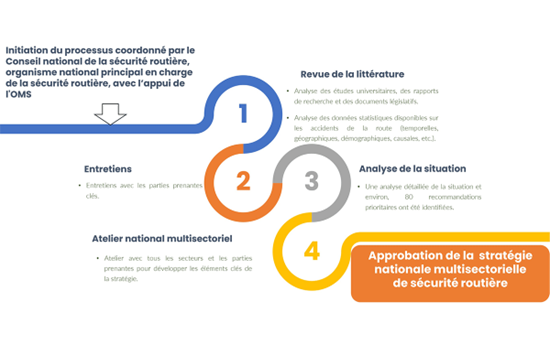Multisectoral road safety strategy for Tunisia
Customer success story

According to the Global Status Report on Road Safety published by the World Health Organization (WHO) in December 2023, the number of deaths due to road accidents in Tunisia exceeds 2,000 per year, with a rate of 16 deaths per 100,000 inhabitants, which represents a significant cost for the Tunisian economy[1]. One of the main achievements highlighted in the 2023 World Report is the reduction in the road mortality rate estimated by the WHO from 24 per 100,000 in 2016 to 16 per 100,000 in 2021, thanks to a multi-sectoral national effort aimed at improving the reporting of road accident deaths in 2019-2020.
Building on the findings of the 2023 Global Report, Tunisia is the first country in the Eastern Mediterranean Region to have developed a multi-sectoral national road safety strategy, after the launch of the said report, based on the Global Plan for the Decade of action for road safety 2021-2030 and on the Regional Strategic Framework to strengthen road safety systems. This initiative began in 2022, under the coordination of the National Road Safety Council, the main national body responsible for road safety, with the support of WHO and conducted by Agilysis. The first step was to carry out a situation analysis to support the strategy.
It included a documentary analysis, interviews with the main stakeholders of the sectors concerned, followed by an extensive consultation within the framework of seminar-workshops with the different stakeholders, in order to validate the analysis and extrapolate the results to define specific commitments and recommendations, at the heart of the national multi-sectoral strategy (figure 1).
Different sectors, governmental and non-governmental, demonstrated a high level of engagement and multi-sectoral coordination throughout the process (Figure 2).
The priority actions included in the strategy have been grouped into five main pillars: infrastructure safety and safe speeds, multimodal transport, road user safety, vehicle safety and post-crash response. The actions were classified as follows: short-term actions, which are expected to be completed in less than two years; medium-term actions, which should be carried out within three to five years; and long-term actions, the full implementation of which will take more than five years.
In addition to priority actions, the strategy also describes enabling actions, particularly in terms of governance, performance management, capacity building and resource mobilization.
The national strategy was recently approved on March 5, 2024 during the meeting to approve the national multisectoral road safety strategy and the launch of sectoral action plans by the Minister of the Interior within the framework of the National Road Safety Council. road safety [1] . This historic step will be followed by the development of operational plans that assign responsibility for identified actions and confer appropriate resources to relevant agencies for implementation on the ground.

Figure 1: Process for developing the multisectoral national strategy on road safety in Tunisia

Figure (2): Institutions and sectors involved in the strategy development process




